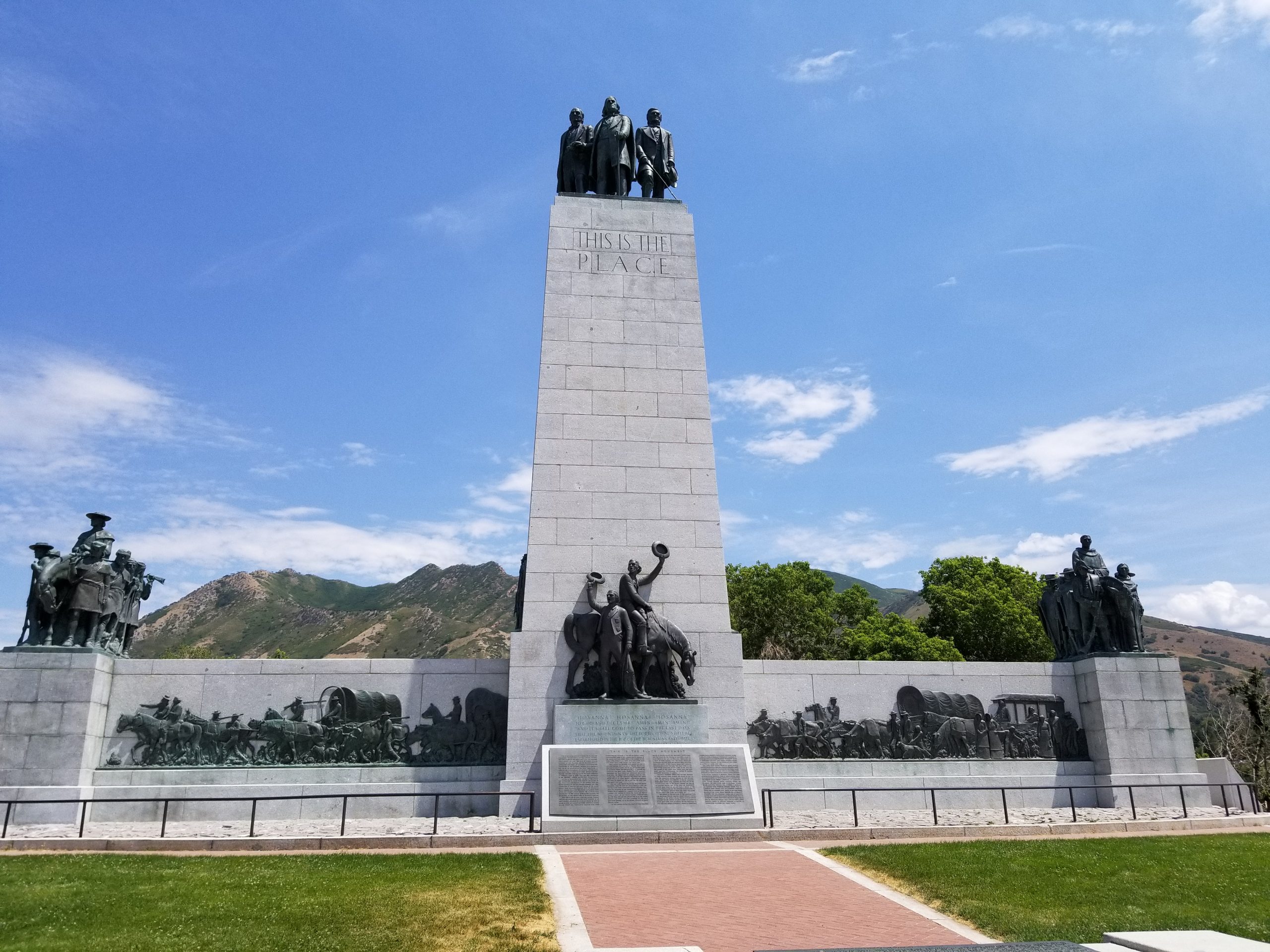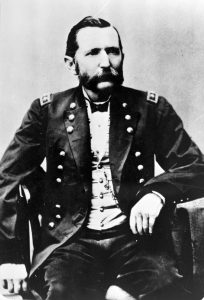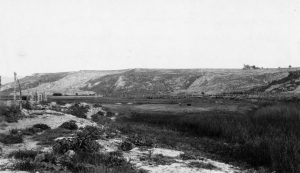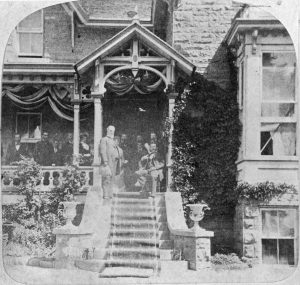Connor Statue at Historic Park
Write-up by Zach Vayo
GPS Coordinates: 40.764399°N, 111.832891°W
Historical Marker Text:
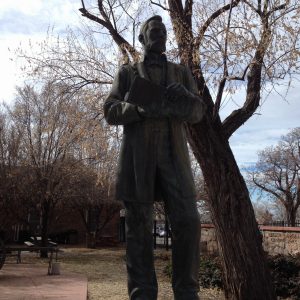 “PATRICK EDWARD CONNER BRIGADIER GENERAL AND BREVET MAJOR GENERAL UNITED STATES VOLUNTEERS 1820-1891
“PATRICK EDWARD CONNER BRIGADIER GENERAL AND BREVET MAJOR GENERAL UNITED STATES VOLUNTEERS 1820-1891
Born in County Kerry, Ireland. Emigrated as a child to the United States. Enlisted in the army at age 19. Attained rank of Captain in the Mexican War. As Colonel, commanding the Volunteers, established Camp Douglas on Oct. 26, 1862. A soldier-statesman of great energy and vision, he was the “father of Utah mining”, published the first daily newspaper in Utah Territory, and founded Stockton, Utah. * * * * This park presented to the United States Army by the Fort Douglas Museum Association on the 124th Anniversary of the founding of Fort Douglas. Oct 26, 1986.”
Extended Research:
Aside from Brigham Young, perhaps no individual played a larger role in shaping nineteenth century Utah than Patrick Connor. Indeed, prominent Utah historian Dean May has hailed these men as the two founding fathers of modern Utah.[1] Today, Connor’s statue in Fort Douglas quietly rivals Young’s much grander memorialization across Salt Lake in Temple Square – a silent reenactment of what was in its day a bitter public rivalry between these two men and their competing visions. Young sought to establish Utah as the Kingdom of God on Earth according to the unique sensibilities of the LDS Church. Connor, meanwhile, aimed to bring Utah into the American mainstream by conquering the land’s indigenous peoples and opening the door for white settlers like himself, looking to make their fortunes out West. Intensely distrustful of Utah’s Mormon population, Connor was himself an immigrant who, having undergone a process of Americanization, now sought to “Americanize” Utah along the same lines as the rest of the West. Portrayed as everything from hero to murderous plunderer, Connor has been sweepingly characterized as “the archetypal nineteenth century man”, who was “representative of all that was good and bad in that age.”[2]
The man who would come to identify himself as P. Edward Connor was born Patrick Edward (“Paddy”) O’Connor in County Kerry, Ireland. Very little information exists on Connor’s early life; he claimed to have been born on St. Patrick’s Day, 1820.[3] Economic stagnation in Ireland drove his family to emigrate to New York when he was perhaps sixteen. Connor spent several years working odd jobs as a laborer before beginning his military career by volunteering for the First Dragoons in 1839. It is possible the young Irishman viewed military service as a useful means to “Americanize” himself in an era animated by nativism and anti-Catholicism.[4]
Connor’s five year tour with the Dragoons took him to the lands in and around the newly-created Iowa Territory to maintain relations with the region’s native peoples. This fledgling military presence in the trans-Mississippi West, with the US fresh off the Jacksonian ethnic cleansing of native peoples in the East, would foreshadow atrocious military violence against the indigenous peoples of the West during and after the Civil War, in which Connor himself was to play a leading role.
While relatively uneventful, Connor’s tour with the Dragoons gave him valuable experience as a soldier. More importantly, he appeared to become enamored with the West, where he would spend almost all of the remainder of his life. Following the end of his tour of duty, he returned to New York for several years, engaging in “mercantile business” and becoming a naturalized citizen (a process no doubt made easier by his military record).[5] Also around this time, he removed some of the conspicuous Irish-ness from his name by dropping the O’ in his surname and shortening Patrick to an initial, becoming P. Edward Connor. With the outbreak of war with Mexico in 1846, Connor headed west again, joining a company of Texas Volunteers. He participated in the US victory at the Battle of Buena Vista, receiving praise for his bravery.[6]
The war resulted in the US seizure of a vast swath of land claimed by Mexico. Connor was among many who viewed these lands as a place to make it big, travelling to California in 1850 on the heels of the Gold Rush. After an ill-fated attempt to establish a community on the Trinity River, he settled in Stockton. Over the next decade, his numerous entrepreneurial ventures, particularly a gravel quarry on his property, resulted in Connor accumulating a degree of wealth. He emerged as a leading citizen of Stockton and came to head its militia, the Stockton Blues. In 1854, he married Johanna Connor, another emigrant from Kerry County.[7] The couple would raise five children to adulthood, enduring the loss of two sons who died in childhood.
This relatively peaceful period of Connor’s life came to an end in 1861 with the outbreak of the Civil War. Eager to serve his adopted country once more, he took the lead in recruiting several companies of California Volunteers to serve under his command. In spite of his (and his troops’) desire to fight the Confederacy in the East, he found himself assigned to protect overland mail routes in Utah, as the Lincoln administration sought to preserve California’s tenuous connection to the Union.[8] In Utah, Connor’s troops were to serve as an occupying force to both native peoples such as the Shoshone and to the territory’s Mormon population, practitioners of an enigmatic and fanatical religion in the eyes of many, whose loyalty to the country seemed particularly dubious, particularly in light of the 1857 Mountain Meadows Massacre.
During the journey across Nevada, Connor began to hone his reputation as an Indian fighter, launching attacks that killed several dozen Shoshones. Reaching Salt Lake City in 1862, Connor remarked with disgust on the apparent un-Americanness of the Mormons, calling them “a community of traitors, murderers, fanatics, and whores,” claiming “the people publicly rejoice at reverses to our arms,” and “Brigham Young rules with despotic sway.”[9] For their part, the Mormons had good reason to fear federal troops due to the “Utah War” of 1856-58. As such, they were none too happy when Connor, despairing of the state of the old Camp Crittenden (Camp Floyd) in Utah Valley, planted his troops directly above their capital, establishing Camp Douglas on an eastern bench of the Salt Lake Valley on October 26, 1862. Connor cited this new location as all the better to “say to the Saints of Utah, enough of your treason.”[10] Connor’s troops thus became the most visible symbol of “Gentile” (non-Mormon) presence in the territory, sparking a war of words between the two groups lasting for decades.
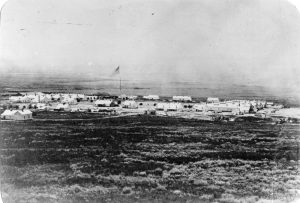
Camp Douglas (later Fort Douglas) ca. 1865. Connor named the fort for Lincoln’s great political rival, Stephen Douglas.
The year 1863 was a critical one for Connor. Denied the chance to fight in the East, he seized on a chance to “chastise” the Northwestern Shoshone instead. Increased Anglo-American incursions into what is today southern Idaho had strained relationships with the Shoshone, producing intermittent fighting and claims of kidnapping. In the bitter cold of January, Connor marched his troops from Camp Douglas to a Shoshone encampment on the Bear River. One California newspaper offered a telling insight into the attitudes of the day by publishing a gleeful letter from a Salt Lake correspondent, stating that “before [Connor’s troops] quit the entertainment Mr. Redskin is to be well thrashed, and, if possible, ‘wiped out.’”[11]
Arriving at the encampment, Connor’s troops launched an attack on the 29th of January. What began as a battle became a bloodbath as Connor’s troops flanked the Shoshones, trapping them in a ravine. The troops proceeded to massacre anyone within reach, including women and children. The death toll may well have exceeded four hundred, making it the largest massacre in the history of the American West. Connor’s troops destroyed homes and food supplies, murdering dozens more women who refused to submit to rape by the soldiers.[12] His actions would make him one of the most despised figures in Shoshone memory, with one survivor, Sagwitch, later recalling the bitter irony of “that merciless battle, when women and suckling babes met their death at the hands of civilization.”[13] Those same actions, however, made Connor a hero to white colonizers in the West, and earned him a promotion to brigadier-general.
Back in Salt Lake, Connor became fixated on the notion of publicizing Utah’s mineral wealth so as to draw non-Mormons into the territory, contending that “inducements … to the teeming population of the East and West, seeking new fields of exploration and prosperity” would spell political and social doom for the Mormonism that he saw as “not only subversive of morals, in conflict with the civilization of the present age, and oppressive on the people, but also deeply and boldly in contravention of the laws and best interests of the nation.”[14] To that end, he founded the Daily Union Vedette, a staunchly non-Mormon newspaper that wrote extensively on the wealth to be had in Utah. Connor helped to establish and personally invested in numerous mining districts, including what would become Bingham Canyon, earning the honorific “father of Utah mining.” In 1863, Connor also established the town of Stockton, near Tooele, named for his former home in California. Connor intended Stockton as a hub for non-Mormon settlement, though his grand visions could never elevate it beyond a minor settlement on the fringes of Brigham Young’s Mormon kingdom. Of course, Young and his disciples were none too happy to see these capitalistic incursions into their Zion. After Young petitioned unsuccessfully to have Connor and his troops removed from Utah,[15] he was spared of the general for a time when Connor was sent to present Wyoming for the Powder River expedition in 1865.
Connor thus departed Utah to crush resistance from the Cheyenne, Sioux, and Arapaho in response to a mining boom that had drawn a wave of white colonizers into Montana. While Connor’s campaigns failed to win any “victories” as decisive as that at Bear River, he nonetheless killed several hundred indigenous persons in a series of battles and skirmishes such as Tongue River (at times fighting alongside indigenous allies such as the Omaha). Such militancy undermined the capacity of indigenous communities to sustain themselves, leaving little recourse to federal economic dependency and reservations (with poverty ironically reinforcing white perceptions of indigenous nations as primitive and backwards). The Powder River endeavor was largely regarded as a failure, in part due to negative publicity surrounding another event to the south: namely, the army’s 1864 Sand Creek Massacre against the Cheyenne and Arapaho, which had soured the nation for a time on war with native nations.[16] Reflecting this shift in attitude, the Salt Lake Tribune expressed desire for “some sensible plan” regarding “the poor Indian race.”[17]Nonetheless, the expedition cemented Connor’s status as to hero to white colonizers in the West. This would be Connor’s last major military mission, as he resigned his commission in 1866.
After a brief return to Utah (and a trip to Washington DC to testify against the evils of the Mormons), Connor returned to California with his family. By 1869, however, the looming completion of the transcontinental railroad brought him back to Utah. This time, his family stayed in California, establishing a permanent residence in Redwood City. Over the next decades, Connor would become increasingly estranged from his family as he bounced between various mining and railroad endeavors in Utah and Nevada in largely unsuccessful attempts to amass his fortune, made all the more difficult by the market instabilities laid bare in the Panic of 1873. Johanna Connor would eventually die in 1889, making no mention of her oft-absent husband in her will.
In Utah, the railroad spelled doom for Brigham Young’s bucolic conception of an economically isolated Zion. Anticipating an economic and demographic influx to the territory, Connor took an interest in the town of Corinne, near the mouth of the Bear River, which emerged in the wake of the railroad’s completion as Utah’s leading non-Mormon community. His assessment of this emerging landscape proved somewhat overly optimistic, with his vision of a steamboat service across the Great Salt Lake connecting Corinne to Stockton never truly materializing. As the most esteemed non-Mormon in the territory, Connor became the symbolic leader of Utah’s anti-Mormon Liberal Party, which denounced polygamy and sought to block statehood for fear of losing federal leverage against the dominant religion. Speaking at an 1880 Liberal rally, Connor declared his intention of “taking up the fight with renewed vigor,” and “helping forward the good work of regulating and Americanizing Utah.”[18] This symbolic leadership notwithstanding, Connor proved unsuccessful in parlaying his notoriety into political office, losing a bid even for the modest office of Salt Lake County Recorder. He died in Salt Lake in 1891 with much prestige and little wealth, and was buried in the Fort Douglas Cemetery.[19]
The decades after his death saw Patrick Connor’s vision of an Americanized Utah come to fruition to a remarkable degree. Booming mining industries throughout the new state in regions such as Carbon County and Bingham Canyon attracted waves of non-Mormon immigration from countries including Greece and Italy, and, to a lesser extent, Japan and China. Mining in particular signified Utah’s increasing integration into the national economy; while providing economic opportunity, this new colonial economy also spawned appalling working conditions and environmental degradation. Connor would no doubt also have been pleased to see the LDS church, the object of his perpetual contempt, take a firmer stance against polygamy and recede from the political sphere in the first decades of the twentieth century (though the latter change did not prove permanent). Furthermore, the twentieth century also saw emphasis on Brigham Young’s model of economic cooperation decline as many Mormons made their peace with Connor’s capitalist vision. Indeed, while not abandoning their distinct identities, Mormon communities have undergone a noteworthy degree of Americanization since Connor’s time.[20] Connor himself practiced what he preached with regards to Americanization: the Irish-born immigrant epitomized the self-made man of fame and fortune. While this rugged, romantic image has become iconic in conceptions of the West, Connor’s case also illustrates its shortcomings. Never truly successful in making his fortune later in life, his obsessive quest for wealth resulted in considerable alienation from his family. Underpinning all of this is Connor’s darkest legacy (and one that is conspicuously absent from his historical marker): the brutalization of indigenous nations, on whose dispossessed land the processes of “Americanization” played out. Particularly for the Northwestern Shoshones, the impacts and bitter memories of Colonel Connor’s atrocious actions on the Bear River echo into the twenty-first century.
For Further Reference:
Primary Sources:
P. Edward Connor, Official Report on the Bear River Massacre, February 6, 1863.
Secondary Sources:
Madsen, Brigham. Glory Hunter: A Biography of Patrick Edward Connor. Salt Lake: University of Utah Press, 1990.
May, Dean. Utah: A People’s History. Salt Lake: University of Utah Press, 1987.
Varley, James. Brigham and the Brigadier: General Patrick Connor and His California Volunteers in Utah and Along the Overland Trail. . Tucson: Westernlore Press, 1989.
[1] Dean L. May, Utah: A People’s History (Salt Lake: University of Utah Press, 1987), 194.
[2] James Varley, Brigham and the Brigadier: General Patrick Connor and His California Volunteers in Utah and Along the Overland Trail. (Tucson: Westernlore Press, 1989), x.
[3] Brigham Madsen, Glory Hunter: A Biography of Patrick Edward Connor (Salt Lake: University of Utah Press, 1990), 3-5.
[4] James Varley, Brigham and the Brigadier, 2.
[5] Brigham Madsen, Glory Hunter, 18-19.
[6] James Varley, Brigham and the Brigadier, 4.
[7] Brigham Madsen, Glory Hunter, 30.
[8] Ibid, 48.
[9] P. Edward Connor, letter to Major R. C. Drum, September 14, 1862.
[10] Ibid.
[11] “A Big Expedition – Connor and the Volunteers after the Indians,” Sacramento Daily Union (Sacramento, CA), Feb. 7, 1863
[12] Scott Christensen, Sagwitch: Shoshone Chieftain, Mormon Elder, 1822-1887 (Logan: Utah State University Press, 1999), 52.
[13] F.W. Warner (Sagwitch), “Sagwitch Writes The Citizen About New Monument,” Franklin County Citizen (Preston, ID), Jul. 11, 1918.
[14] P. Edward Connor, letter to Major E. McGarry, October 26, 1863.
[15] Brigham Madsen, Glory Hunter, 114.
[16] Ibid, 121.
[17] James Varley, Brigham and the Brigadier, 258.
[18] Brigham Madsen, Glory Hunter, 237.
[19] Brigham Madsen, Glory Hunter, 271.
[20] Dean L. May, Utah: A People’s History, 190, 194-198.
